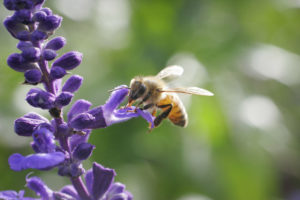
Saving the bees is easy with a little thoughtful landscaping.
The mantra is everywhere these days—save the bees. The thing is, bees are an integral part of Earth’s ecosystems and they are incredibly beneficial for the environment as well as humans. Bees are part of the foundation of successful crop growth—if it’s a flowering crop, it needs the help of bees. Bees are critical to our survival, and humans are critical to the survival of bees. Thankfully, you can help save the bees with a little thoughtful landscaping.
Grow Native Greenery
Growing native greenery is the best way to feed your native bees. As an added bonus, native flowers, trees, and shrubs are already suited to your plant hardiness zone and will not require much upkeep and maintenance. They are good at mitigating weed growth, and they don’t need fertilizer or extra care to keep them happy and healthy since they’re in their natural habitat. On that note, don’t stop at flowers! Bees can also get nectar from shrubs and trees, such as the American Basswood (which is native to Maryland).
Consider Blooming Times
Think about the time of year your plants will flower and plan for a wide range of blooming times to keep the bees fed year-round. The longer your blooms last, including through winter, the longer the bees will have a ready food source. Planting flowering fruits and veggies can help with this if you leave the plant intact after harvest. Some of these, such as broccoli plants, will flower in the winter and provide sustenance for your nearby bees. Planting flowering fruits and veggies is a win-win—it feeds you and the bees. Plus, bees pollinating your fruit and veggie plants can actually help them grow, giving you even better harvests.
Go for Density
Whatever you plant, plant a lot of it. Having a large section of a single plant will attract more bees during its blooming season than if you plant sparingly or scatter them. There are still great ways to create a garden with dense sections of the same plant that looks amazing and gets people talking. Color-coordinate your sections to make a rainbow, or create a pattern of contrasting colors that creates tons of visual appeal. You can also break up sections of flowers with bee-friendly shrubbery to give the bees more food sources without sacrificing a high-end look for your garden.
Avoid Chemicals
Absolutely no chemicals should be used in your yard if you’re hoping to attract bees. These chemicals, even if not directly applied to the plants, can be harmful to the bees and do significant damage to the population if they’re trying to utilize the food sources you’ve provided. Avoid chemical pesticides, fungicides, herbicides, and insecticides along with any other dangerous chemicals such as fertilizer with additives. Do a little research into chemical-free ways to keep your lawn and garden looking beautiful so that you can continue to enjoy your local bee population.
LAWN CARE MADE EASY WITH HONEYSUCKLE NURSERY & DESIGN
At Honeysuckle Nursery and Design, you will get construction and maintenance crews on site who have a minimum of 10 years of experience in all types of landscaping and hardscaping. Our designers will work closely with you to understand how you want to use your space so that we can make the most of your entire site. We are committed to providing complete customer satisfaction and will work with you along every step of the way to be sure that you are happy with your new trees. Please be sure to visit our gallery page for unique, creative designs and inspiration!
Whether you live in Anne Arundel or Howard Counties, we can help you experience your dream space in Annapolis, Davidsonville, Millersville, Ellicott City, Clarksville, Columbia, and surrounding areas. We specialize in Landscape Design & Maintenance, Swimming Pools, Hardscape, and Natural Stone, Water Features, Outdoor Living Spaces, and more! Dream, Create, Experience with Honeysuckle Nursery & Design by calling 410-849-5119 or email us to schedule your free no-obligation estimate today. Follow us on Facebook, Twitter, Houzz, and YouTube!
